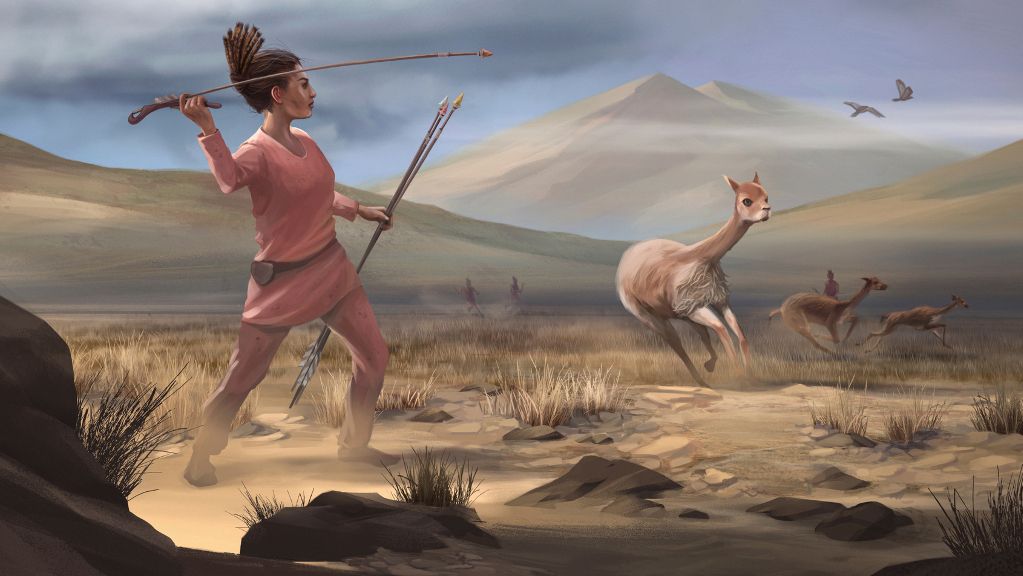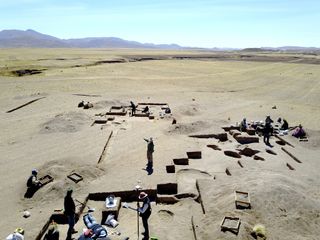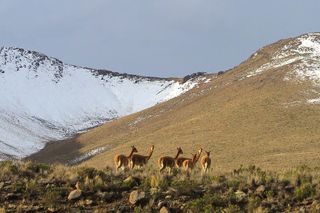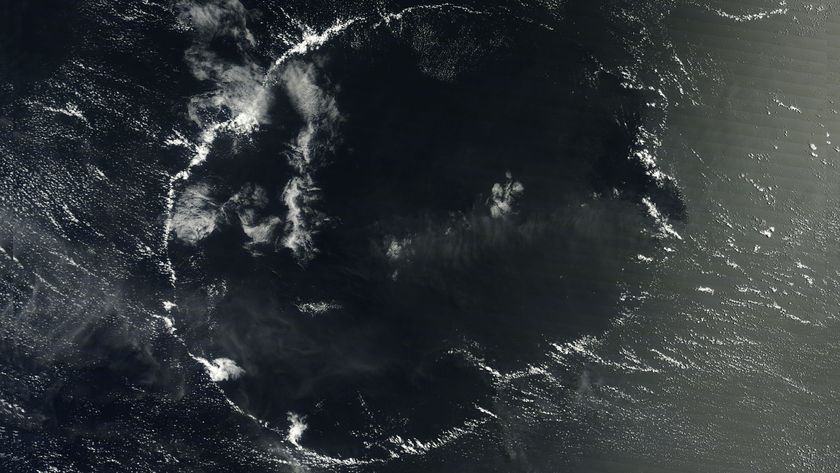Ancient burial of fierce female hunter (and her weapons) discovered in Peru
Early hunter-gatherer women in the ancient Americas hunted big game just as much as men did, a new study suggests.

Silently moving in the wilderness of the Andes mountains, ancient hunter-gatherers stalked a herd of vicuña. The hunters threw stone projectile points with ease, hitting some of the beasts and leading the rest to scatter. The vicuñas, wild ancestors of alpacas, fell and the skilled hunters — both females and males — went to examine their wins.
This somewhat hypothetical account is in stark contrast to the accepted history of such hunter-gatherers: ancient men hunted big game, while women gathered herbs and plants. But a recently discovered 9,000-year-old burial of a female hunter, and analyses of other hunter burials, suggests that early hunter-gatherer women in the ancient Americas hunted big game just as much as men did, according to a study published on Nov. 4 in the journal Science Advances.
"These findings sort of underscore the idea that the gender roles that we take for granted in society today — or that many take for granted — may not be as natural as some may have thought," said lead author Randy Haas, an assistant professor of anthropology at the University of California, Davis.
Related: In images: an ancient European hunter-gatherer
In 2013, Haas was working on a different excavation in the Andes Mountains when a local from the nearby southern Peruvian community of Mulla Fasiri reported there were hundreds of ancient stone tools scattered nearby. Five years later, after securing funding and in collaboration with the locals, Haas and his team started excavating the site, which became known as Wilamaya Patjxa.
In 2018, the researchers discovered six human burials at Wilamaya Patjxa (they later discovered more in 2019). Two of the six burials also contained hunting tools, but one was particularly interesting.
In the sixth burial, dating back around 9,000 years, "we started to uncover this really rich artifact assemblage" including a hunting toolkit with projectile points and flakes, Haas told Live Science. The burial is thought to belong to a hunter-gatherer who, based on examination of tooth development, died between the ages of 17 and 19. As the excavation continued, "people began to speculate 'Wow, he must've been a great hunter, a really important person in the community,'" Haas said.
Sign up for the Live Science daily newsletter now
Get the world’s most fascinating discoveries delivered straight to your inbox.

The bias that colors history
James Watson, an associate professor of anthropology at the University of Arizona, and co-author of the study, was the first to suggest this was not a man at all. Watson examined the hunter-gatherers' bones and said that because they were smaller compared with others found in the region, the skeleton could be a female. Indeed, a detailed analysis of proteins in the young hunter-gatherer's teeth confirmed that she was a female.
But then Haas and his team began to wonder: Is this a one-off female hunter, or is she part of a larger behavioral pattern among ancient Americans? To figure this out, they combed through the literature for reports of other hunter-gatherer burials from the late Pleistocene (which ended around 11,700 years ago) and the early Holocene (which began around 12,000 to 11,500 years ago.)
The team identified 429 skeletons from 107 ancient burial sites across the Americas; 27 of those individuals —11 female (including the newly discovered female) and 15 male — were buried with big-game hunting tools. Further statistical analysis suggested that between 30% and 50% of hunters in these populations were female. "What we see is that female and male burials are just as likely to be associated with big-game hunting tools," Haas said.
Related: Photos: Human skeleton sheds light on first Americans

"The authors make a compelling argument that the female skeleton in question was likely a big-game hunter and that such a finding is not entirely unusual throughout Indigenous populations," said Marin Pilloud, an associate professor in the Department of Anthropology at the University of Nevada, Reno, who was not a part of the study."If the same artifacts had been associated with a male skeleton, there would be no questions that the individual was a hunter."
Many cultures did not — and still do not — have the gender binary "that dominates our modern Western culture," Pilloud told Live Science. "When we step back from our own gendered biases can we explore the data in nuanced ways that are likely more culturally accurate."
It's not clear whether hunter-gatherer females in other parts of the world also partook regularly in hunting, but it's absolutely possible to discover similar findings elsewhere, she said. It would've been interesting to see how this female's diet compared with other females in the site or similar sites to determine whether she ate foods more similar to other males or to other females, she added.
"This study should help convince people that women participated in big-game hunts," said Kathleen Sterling, an associate professor of anthropology at Binghamton University in New York, who also was not part of the study.
In fact, the methods used to hunt and the size of social groups at the time, "means that we should have been assuming this all along, since most older children and adults would have been needed to drive herds over cliffs or into traps, or to fire projectiles at herds moving in the same direction," Sterling told Live Science.
Age was probably more important than gender when it came to who hunted in these societies, but "our gender norms are so strong that not everyone will be convinced," she said.
Still, if an individual is buried with hunting tools, it doesn't necessarily mean that the person was a hunter, it just means their society thought it appropriate to bury the objects with them, Sterling said. But when hunting tools are found in mens' burials, they're typically assumed to be hunters. So "we should make the same assumption about hunting tools buried with women unless we have good reason to say otherwise," she added.
Originally published on Live Science.

Yasemin is a staff writer at Live Science, covering health, neuroscience and biology. Her work has appeared in Scientific American, Science and the San Jose Mercury News. She has a bachelor's degree in biomedical engineering from the University of Connecticut and a graduate certificate in science communication from the University of California, Santa Cruz.












